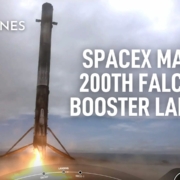SpaceX launches Euclid Space Telescope
SpaceX launches the Euclid Space Telescope for the European Space Agency. Launching at 11:12 a.m. ET from Space Launch Complex 40 at Cape Canaveral Space Force Station, the rocket’s nine Merlin 1D engines ignited and sent Falcon 9 and Euclid to space. It landed back on Earth just over eight and a half minutes later. This was the second launch for the Falcon 9 Booster 1080. Its first-stage engines burned for just over two-and-a-half minutes before stage separation and eventual ignition of the single Merlin 1D MVac second-stage engine, which performed a burn for just over five minutes. Then followed a nine-minute coast phase, and the second stage reignited for a 90-second engine burn to set up momentum for Euclid to be sent on its way to the Lagrange point 2 transfer orbit. After the 2nd stage coasted for approximately 20 minutes, spacecraft separation took place. SpaceX used brand new fairings for the launch.
200th Falcon 9 booster landing
In a rideshare mission called Transporter-8, SpaceX launches a Falcon 9 rocket containing 72 small satellites from California’s Vandenberg Space Force Base to orbit and lands the returning booster, eight minutes later, back on Earth, marking the 200th booster landing in SpaceX’s history. This is the ninth launch and landing for this particular booster. The rocket’s upper stage continued hauling aloft the 72 payloads, which included “cubesats, microsats, a re-entry capsule and orbital transfer vehicles carrying spacecraft to be deployed at a later time.” The satellites deployed from the Falcon 9’s upper stage, separate over a 24-minute span, beginning an hour after liftoff. Transporter-8 was SpaceX’s second mission in about 14 hours, the eighth small-satellite “rideshare” mission launched by SpaceX, and its third such flight of 2023.
After delivering 72 spacecraft to orbit, Falcon 9 returns to Earth and completes SpaceX’s 200th landing of an orbital class rocket pic.twitter.com/7Aw52C97jk
— SpaceX (@SpaceX) June 13, 2023

